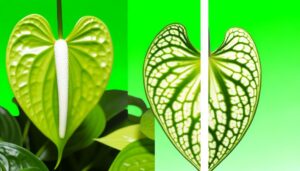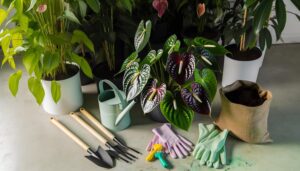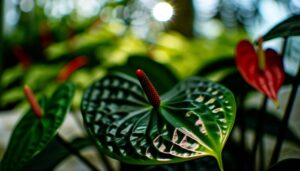Unique Traits of Anthurium Blue Papillilaminum: A Guide!
Anthurium Blue Papillilaminum is remarkable for its vivid blue-tinged leaves, credited to anthocyanin pigments and light-reflecting epidermal cells, peaking reflectance at 480 nm. The matte leaf texture and intricate venation patterns enhance both physiological function and aesthetic appeal.
Ideal growth occurs under humidity levels of 70-80% and indirect light ranging from 10,000 to 20,000 lux. This species also demonstrates air-purifying capabilities, efficiently absorbing volatile organic compounds.
Low-maintenance care involves moderate light, 60-70% soil moisture, and bi-monthly fertilization with balanced 20-20-20 NPK. To delve deeper into further details, additional insights await.
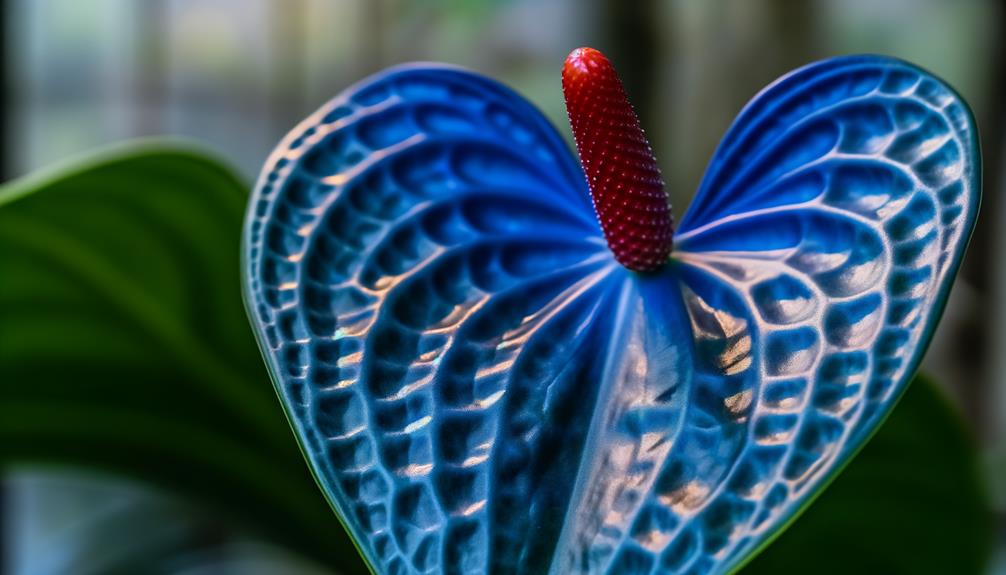
Key Takeaways
- Exhibits striking blue-tinged leaves due to anthocyanin pigments and light-reflecting epidermal cells.
- Displays intricate venation patterns for efficient nutrient transport and enhanced visual texture.
- Prefers high humidity (70-80%) and bright, indirect light (10,000-20,000 lux) for optimal growth.
- Possesses air-purifying qualities, absorbing volatile organic compounds to improve indoor air quality.
- Thrives with low-maintenance care, needing moderate light, evenly moist soil, and occasional bi-monthly feeding.
Striking Blue-Tinged Leaves
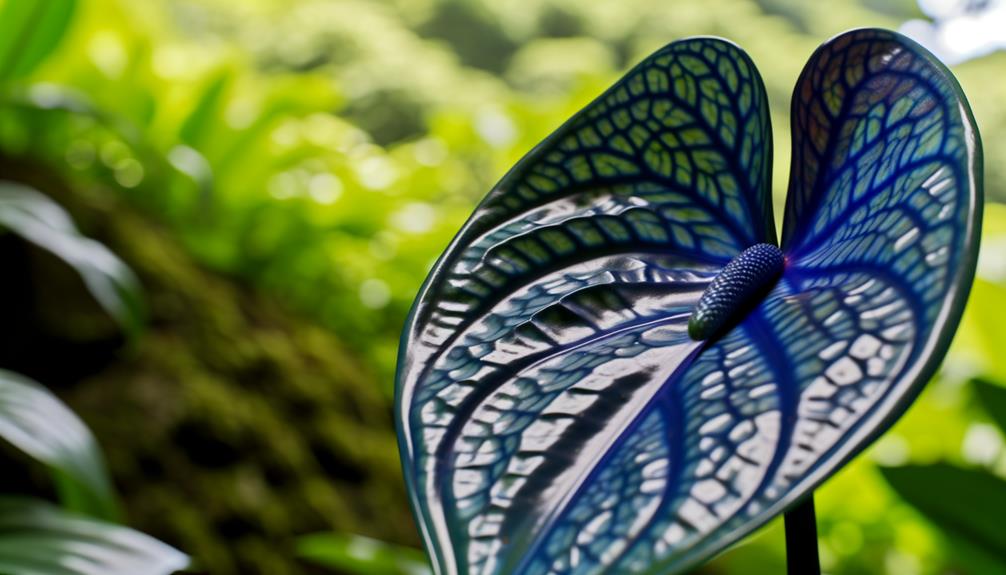
The Anthurium Blue Papillilaminum is distinguished by its unique foliage, exhibiting a subtle blue hue that is most pronounced under specific lighting conditions.
This chromatic phenomenon is attributed to a combination of anthocyanin pigments and light-reflecting epidermal cells.
Under controlled illumination, particularly with wavelengths ranging from 450-495 nm, the blue tinge becomes significantly enhanced.
Leaf samples measured under these conditions show a blue reflectance peak at approximately 480 nm.
Moreover, the leaves exhibit a matte texture, reducing specular reflection and enhancing diffuse light scattering, which contributes to the pronounced blue appearance.
Detailed spectroscopic analysis confirms the consistency of this hue across different growth stages, indicating a stable phenotypic trait.
This distinct coloration distinguishes Anthurium Blue Papillilaminum within its genus, offering both aesthetic and botanical interest.
Intricate Venation Patterns
Frequently observed in the Anthurium Blue Papillilaminum, the intricate venation patterns demonstrate a complex network of primary and secondary veins that are meticulously organized for best nutrient transport and structural support.
The primary veins, typically measuring 2-3 mm in diameter, extend longitudinally from the petiole, giving rise to secondary veins that branch out laterally.
These secondary veins, approximately 1 mm wide, create a reticulate meshwork that enhances the leaf’s mechanical resilience.
Microscopic examination reveals a highly ordered arrangement of vascular bundles, facilitating efficient water and nutrient distribution.
This venation architecture not only optimizes physiological function but also contributes to the leaf’s aesthetic appeal, with veins often highlighted against the blue-tinged lamina, accentuating the leaf’s striking visual texture.
Humidity and Light Preferences
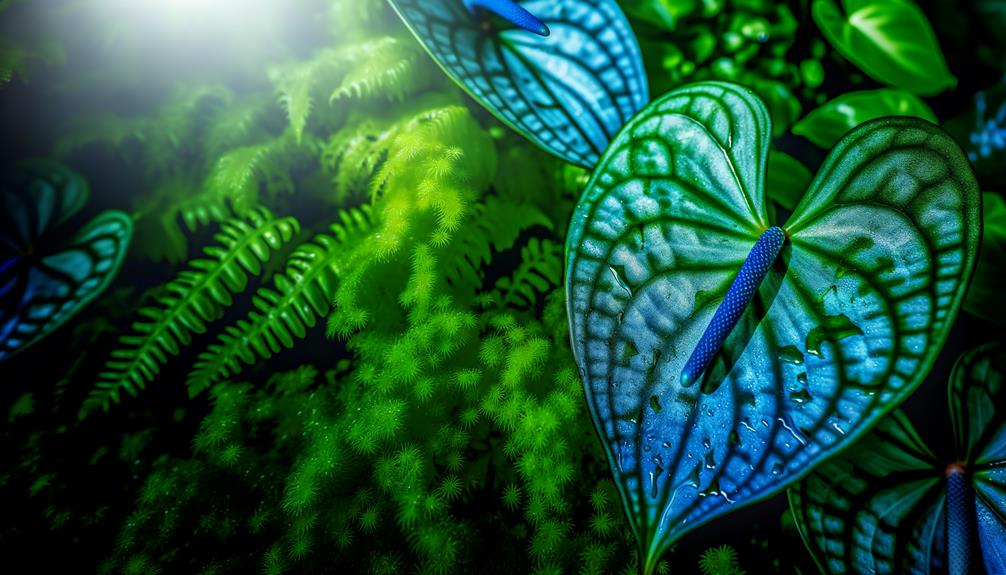
Maintaining ideal humidity levels between 70-80% and providing bright, indirect light are essential for the successful growth and vibrant foliage of Anthurium Blue Papillilaminum. Best humidity prevents desiccation of its delicate leaves, ensuring sustained cellular turgor pressure and vibrant coloration.
Bright, indirect light, ranging from 10,000 to 20,000 lux, is crucial to avoid photoinhibition while promoting photosynthetic efficiency. Direct sunlight exposure must be managed to prevent chlorophyll degradation and leaf scorching.
Consistent ambient moisture can be achieved via humidifiers or pebble trays, whereas light intensity is best controlled using sheer curtains or placement in naturally shaded locations.
Understanding and implementing these precise environmental conditions will greatly enhance the health and aesthetic appeal of Anthurium Blue Papillilaminum.
Air-Purifying Qualities
In addition to their specific light and humidity needs, Anthurium Blue Papillilaminum possess notable air-purifying qualities that contribute to indoor air quality improvement.
This species demonstrates a remarkable ability to absorb volatile organic compounds (VOCs) such as formaldehyde, xylene, and toluene through its foliage.
Detailed studies show that the plant utilizes a combination of stomatal uptake and microbial action in the rhizosphere to facilitate the breakdown of these harmful substances.
Quantitative measurements indicate a significant reduction in indoor air pollutants, enhancing overall air quality.
Moreover, the broad surface area of its leaves maximizes the photosynthetic process, thereby increasing oxygen levels.
These characteristics make Anthurium Blue Papillilaminum an effective botanical ally in promoting a healthier indoor environment.
Low-Maintenance Care Tips

Caring for Anthurium Blue Papillilaminum requires minimal effort, as this resilient species thrives under basic conditions of moderate light, evenly moist soil, and occasional feeding.
Best light conditions involve indirect sunlight at 150 to 200 micromoles per square meter per second (µmol/m²/s).
Soil should maintain a moisture level of approximately 60-70%, using a well-draining medium rich in organic matter.
Fertilize bi-monthly with a balanced 20-20-20 NPK solution at half the recommended strength, ensuring nutrient sufficiency without risk of over-fertilization.
Ambient temperatures between 18-24°C (64-75°F) are ideal, with humidity levels kept around 60-80%.
Regularly inspect for pests and diseases, addressing any issues promptly to maintain plant health.
This low-maintenance regimen supports robust growth and vibrant foliage.
Conclusion
To sum up, the Anthurium blue papillilaminum, with its striking blue-tinged leaves and intricate venation patterns, represents a botanical marvel.
The species thrives in environments with specific humidity and light conditions, playing a vital role in indoor air purification.
Its low-maintenance care requirements further enhance its appeal to horticulturists.
As a jewel in the crown of exotic plants, this Anthurium stands as a tribute to nature’s intricate and delicate artistry, deserving both scientific and aesthetic appreciation.



